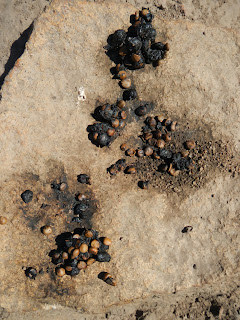Cabrillo Peak is a volcanic plug and part of a chain of volcanic peaks here that are known collectively as "The Morro's" and also as "The Seven Sisters" to natives and longtime locals [They're sometime incorrectly called "The Nine Sisters" by people who want to count an offshore sea mount that has not conclusively been proven to belong to the system].
A view of The Morro's from atop Portola Trail
There are several trail heads around the perimeter of the property, but the day use area can most easily be accessed from the Quarry parking lot on South Bay Boulevard, about a half mile south of Morro Bay State Park Road. There is a parking lot with room for, I don't know, maybe a dozen cars or so. It's also infrequently patrolled by Rangers and hidden from road view, so be sure to lock up your valuables out of sight.
The Cerro Cabrillo day use trails are sun-exposed and there is no water, so make sure you take extra water and some trail necessities like a small First Aid kit, tissues, etc.
Fanny pack trail kit with water bottle & First Aid kit
I started the hike at around 12 Noon, and there had already been many mountain bikers and hikers on the trail. This obliterates a good deal of the wildlife tracks made the night before and early that morning. It would be necessary to watch the cover along both sides of the trail and game trails leading away from the trail if I hoped to see any tracks. This is usually not a problem though, as most animals tend to hug the protection of the vegetation and chaparral closely in case they need to suddenly run and evade a predator.
Not far up the Quarry Trail I spotted a recently made oval-shaped dog track on a narrow game trail leading into the brush. Outside the opening there were none of these tracks, as would be expected of a hiker with a domesticated dog, so its possible this track was left by a Coyote hunting the cover:
Canine track, possible Coyote
Just a short distance beyond I came across a pile of scat on top of a rock in the center of the trail. It was full of berries. It's hard to say what made this...could be a Raccoon. Basically, scat is made up of whatever the animal didn't digest. There's also purpose in placement; it's kind of a way for an animal to communicate it's territory to competitors. There was a game trail on one side, and that's common on these "boundary marker" scats:
Berries in scat
Be sure not to handle scat. It can be full of harmful parasites. If you must break one open to study contents, wear protective latex disposable gloves, use sticks to break up the material, and keep away from face and exposed skin.
Just a short distance beyond the scat pile I located a batch of tracks from a raccoon, which kind of supports this scat was made by one. In the photo below, the print from a front paw of a Raccoon is visible. they have long fingers on the front paw, which resembles a human hand. The rear paw is elongated and more closely resembles a human foot, however there were none that were photographic quality, so only the front paw is shown here:
Front paw impression from a Raccoon
Another very common form of scat are pellets left by Jackrabbits and Cottontail rabbit's. These you will notice under the brush cover along the sides of trails, as this is where these animals tend to feed. They also stick to the cover for protection from predators like Bobcats.
Rabbit pellet droppings
Another very common animal whose tracks are seen hereabouts in profusion are Black-Tail Deer. In the photo below, you can see deer tracks walking on top of tracks left the day before by hikers and bikers. These fresh tracks appear somewhat reflective of the sunlight. Trackers refer to this condition as "shine".
Deer track "shine"
Some animals [Bobcats, Mountain Lions, Foxes] have "direct register" tracks...in other words, when they move forward, the rear paw lands directly inside the print made by the front paw. Deer are "indirect register" animals, meaning their rear hoof will be close to, but not precisely inside, where there front hoof was placed:
Deer hooves - indirect register
Dusky-Footed Woods Rat den
Male Woods Rats build their dens in trees, thus, this is a female Woods Rat's den. The Woods Rat den as 4 chambers or rooms, which they line with leaves that are toxic to fleas.
The aboriginal peoples used to hunt Woods Rats using a long notched stick. They would push the stick into the den, probe to locate the rat, twist the notched end of the stick into the rat's fur, and then withdraw it from the den. The rat was cooked pretty much intact until it was charred and then they'd pulverize it using a stone mano [hammer stone or pestle] and a metate [a flat grinding stone] and consume bones and all!
As I'd mentioned in my October 10, 2013 post, "Track Awareness", I am by no means an expert tracker, But I learn something new every time I get out on a trail and look for tracks and sign. Locating tracks requires that you develop knowledge of where animals move, how they use cover, and mark their territories, and this can only be learned through study and hands-on "dirt time".
Happy tracking!
© 2013, MANNY SILVA, ALL RIGHTS RESERVED









No comments:
Post a Comment